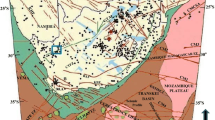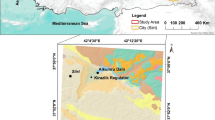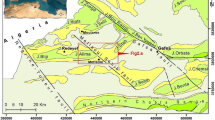Abstract
The Manjil landslide occurred after the slope cutting and the removal of the toe buttress (8 July 2013), between 41 + 400 and 42 + 200 km section of Manjil–Radbar in the Qazvin–Rasht freeway, Gilan Province, Iran. The occurrences of landslide led to blockage of the freeway. A cutting was designed with a width and height of 4 and 6 m, respectively, and a 5 to 6 m excavation depth within a 120 m line along the slope toe. Based on the site investigations, the landslide was characterized as a complex deep-seated landslide, displaying composite rotational-debris flow. Moreover, extensive field survey, subsurface investigation, laboratory and in situ tests show that although the landslide was triggered by an inappropriate cutting, geostructural, geological engineering properties and hydrology have also played a key role in its initiation and further aggravation. Therefore, the western and eastern boundaries of the landslide coincide with the two faults (F1 and F2). In addition, landslide sinisterly movement is controlled by a left lateral strike-slip fault (F2). It was observed that the scarp follows the N130°/75 direction of bedding rocks. The presence of marls and shale implies a high swelling under wet conditions, thus providing lubricating sliding surfaces. In addition, alteration and weathering of andesite, basalt, tuffite, and tuff have been reduced the shear strength of the slope. Engineering geological map (EGM) of the landslide was prepared on the basis of aerial interpretations, the orientation of ground cracks and fissures, geomaterial, geostructural and hydrology. Based on ground cracks and fissures, the displacement vectors are also determined and shown on the map. The relationship between the displacement vectors estimated from ground cracks and fissures with GPS observation and slickness slip surface is coherent.














Similar content being viewed by others
References
ASTM D 1586 (1999) Standard test method for standard penetration (SPT) and split-barrel sampling of soils. American Society for Testing and Materials, Philadelphia
Bowles JE (1992) Engineering properties of soils and their measurements, 4th edn. McGraw-Hill Education, London, United States. ISBN 13 9780079112668
Can E (2014) Investigation of landslide potential parameters on Zonguldak–Ereğli highway and adverse effects of landslides in the region. Environ Monit Assess 186:2435–2447
Chowdhury R, Flentje P, Bhattacharya G (2010) Geotechnical slope analysis. CRC Press, Balkema, Taylor and Francis Group, p 746
Das BM (2008) Advanced soil mechanics. CRC Press, Boca Raton. ISBN 0415420261
Fernandes NF, Guimaraes RF (2004) Topographic controls of landslides in Rio de Janeiro: field evidence and modeling. CATENA 55:163–181
Geological Survey of Iran (1993) 1:100,000 geology map of Rudbar. Geological Survey of Tehran, Iran
G.R.W.A (Gilan Regional Water Authority) (2016) http://www.glrw.ir/
Henriques C, Zêzere JL, Marques F (2015) The role of the lithological setting on the landslide pattern and distribution. Eng Geol 189:17–31
Hu X, Zhang M, Sun M, Huang K, Song Y (2015) Deformation characteristics and failure mode of the Zhujiadian landslide in the Three Gorges Reservoir, China. Bull Eng Geol Environ 74:1–12
Khorsandi A, Ghoreishi SH (2013) Studying the interaction between active faults and landslide phenomenon: a case study of a landslide in Latian, northeast Tehran, Iran. Geotech Geol Eng 31:617–625
Nazari H, Ritz JF, Salamati R, Shafei A, Ghassemi A, Michelot JL, Massault M, Ghorashi M (2009) Morphological and paleoseismological analysis along the Taleghan fault Central Alborz, Iran. Geophys J Int 178:1028–1041
Nichol D, Graham JR (2001) Remediation and monitoring of a highway across an active landslide at Trevor, North Wales. Eng Geol 59(3–4):337–348
Regmi AD, Yoshida K, Dhital MR, Devkota K (2013) Effect of rock weathering, clay mineralogy, and geological structures in the formation of large landslide, a case study from Dumre Besei landslide, Lesser Himalaya Nepal. Landslides 10:1–13
Ritz JF, Nazari H, Ghassemi A, Salamati R, Shafei A, Solaymani S, Vernant P (2006) Active translation inside Central Alborz: a new insight into the northern Iran–Southern Caspian geodynamics. Geology 34(6):477–480
Seed HB, Woodward RJ Jr., Lundgren R (1962) Prediction of swelling potential for compacted clays. J ASCE Soil Mech Found Div Part 1 88(3):55–87
Shahrivar H, Nadim H (2005) The morphology, setting, and processes of Rudbar and Fatalak landslides triggered by the 1990 Manjil–Rudbar earthquake in Iran. M. Sc Thesis, Faculty of Mathematics and Natural Sciences, the University of Oslo, p 212
Shimizu O, Ono M (2016) Relationship of tephra stratigraphy and hydraulic conductivity with slide depth in rainfall-induced shallow landslides in Aso Volcano, Japan. Landslides 13:577–582
Torrebadella J, Lo´pez C, Altimir J, Amigo J, Lo´pez L (2013) Cutting D15: stabilization of a large landslide in Marrakesh. In: Margottini C, Canuti P, Sassa K (eds) Landslide science and practice, vol 6. Springer, Berlin. doi:10.1007/978-3-642-31319-6_26
Varnes DJ (1978) Slope movement types and processes: chapter 2: landslides analysis and control, special report 176. Transportation Research Board, The National Academy of Sciences, Washington, D.C
Wartman J, Montgomery DR, Scott A, Anderson SA, Keaton JR, Jean Benoît J, Chapelle J, Gilbert R (2016) The 22 March 2014 Oso landslide, Washington, USA. Geomorphology 253:275–288
Wei Z, Yin G, Wang JG, Wan L, Jin L (2012) Stability analysis and supporting system design of a high-steep cut soil slope on an ancient landslide during highway construction of Tehran–Chalus. Environ Earth Sci 67:1651–1662
Wen ZH, JianPing CH, Wu ZH, Yan LÜ, YuFei M, Hui X (2013) Determination of critical slip surface of fractured rock slopes based on fracture orientation data. Sci China Technol Sci 56(5):1248–1256
Xu Q, Liu H, Ran J, Li W, Sun X (2016) Field monitoring of groundwater responses to heavy rainfalls and the early warning of the Kualiangzi landslide in Sichuan Basin, southwestern China. Landslides. doi:10.1007/s10346-016-0717-3
Yalcin A (2011) A geotechnical study on the landslides in the Trabzon province, NE, Turkey. Appl Clay Sci 52:11–19
Zhang M, Nie L, Xu Y, Dai Sh (2015) A thrust load-caused landslide triggered by excavation of the slope toe: a case study of the Chaancun landslide in Dalian city, China. Arab J Geosci 8:6555–6565
Author information
Authors and Affiliations
Corresponding author
Electronic supplementary material
Below is the link to the electronic supplementary material.
Rights and permissions
About this article
Cite this article
Ghobadi, M.H., Firuzi, M. & Noorzad, A. A large-scale landslide and related mechanism: a case study in the Qazvin–Rasht freeway, Iran. Environ Earth Sci 76, 478 (2017). https://doi.org/10.1007/s12665-017-6815-2
Received:
Accepted:
Published:
DOI: https://doi.org/10.1007/s12665-017-6815-2




